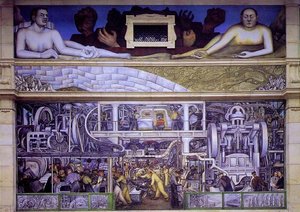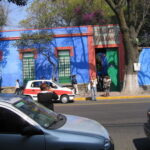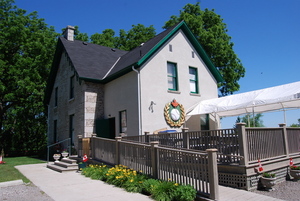From 1931-1932, renowned Mexican muralist Diego Rivera and his artist wife Frida Kahlo lived in Detroit, Michigan. During this period, Rivera worked on a mural project at the Detroit Institute of Art (DIA) that would gain him public controversy.
Edsel Ford and Diego Rivera
Edsel Ford was automobile mogul Henry Ford’s only child and the president of the Ford Motor Company. As head of the Detroit Arts Commission, a part of DIA, Edsel had underwritten the cost of Diego Rivera’s mural project; over $20,000, an approximate equivalent of $300,000 in 2012 money.
This was a bold undertaking on Ford’s part, particularly because Rivera did not hide the fact that he was a Communist Party member in Mexico. The artist clearly stated that his mural’s subject focus would serve to elevate the status of workers. The Detroit Arts Commission required that the murals portray Detroit history and the development of Detroit industry. Rivera titled his mural project “Detroit Industry.”
Despite his leftist politics, Diego Rivera proclaimed his admiration for Edsel’s father, billionaire capitalist/inventor Henry Ford. The muralist called old Ford “a true poet and artist, one of the greatest in the world.”
The original inspiration to hire Diego Rivera to create murals for the museum’s Garden Court, however, came from Dr. W. R. Valentiner, DIA’s director.
When Diego Rivera and wife Frida Kahlo arrived in Detroit, labor unrest was at a fever pitch. Only several days before their arrival, five people were shot in a bloody strike outside the Ford Motors main River Rouge plant.
The Garden Court murals
In 1931, Diego Rivera was originally hired to paint two walls of the DIA’s Garden Court. For inspiration, Rivera and artist wife Frida Kahlo visited the Ford River Rouge plant. For weeks, they observed and photographed the assembly line production process for the 1932 Ford V8. The Rouge plant employed 100,000 workers. For additional artistic inspiration, the husband and wife artists would also spent time at worker hangouts and private homes. Rivera was so inspired by Detroit’s workers and their industrial energy; he asked Edsel Ford and the Arts Commission to paint all four Garden Court walls. They accepted.
Diego painted 27 murals, all done in a classic fresco technique: paint over wet plaster. The artist weighed 316 pounds when he started the project in 1931. With the help of a diet, he had lost 108 pounds by the time the project was at its end in 1933. The temperature under the Garden Court’s glass roof sometimes would hit 120 in the Detroit summertime.
Frida Kahlo’s stay in Detroit would mark the beginning of the most exciting creative work of her career. She included industrial scenes into her Detroit paintings.
The Garden Court Controversy
The Garden Court murals were unveiled to the public in 1933.
Among the project’s multi-paneled mural images Rivera portrayed his chief sponsors, Edsel Ford and DIA head W.R. Valentiner. The mural also depicted multiracial workers toiling side by side.
The project’s most controversial images included workers in gas masks making poisonous gas. This strong leftist image triggered a strong reaction from Detroit city councilman William P. Bradley among other powerful conservative politicians. He called Rivera’s image “a travesty on the city of Detroit.”
Another controversial mural image included doctors and scientists posing with a child in a mock nativity scene. This triggered strong reactions from Detroit religious leaders. Chief among religious leader critics was Dr. Ralph Higgins, the senior curate of Detroit’s St. Paul Cathedral.
Dr. George H. Derry, president of Detroit’s Marygrove College took broader aim, stating that “Senor Rivera has perpetuated a heartless hoax on his capitalist employer.”
Many of the strongest critics wanted the mural whitewashed over, or completely destroyed with plaster frescoes shattered.
The Detroit Arts Commission
The Detroit Arts Commission, led by Edsel Ford and DIA head W.R. Valentiner supported Rivera’s project. As a personal response, Ford would only release this public statement: “I admire Rivera’s spirit. I really believe he was trying to express his idea of the spirit of Detroit.”
Rivera’s Detroit Aftermath
In 1933, New York political powerhouse Nelson Rockefeller, scion of John D. Rockefeller Jr., commissioned Diego Rivera to do a lobby mural project for the RCA Building in Manhattan’s iconic Rockefeller Center. Like DIA’s mural project, Rivera’s RCA Building mural images triggered controversy, particularly from patron Nelson Rockefeller. The most controversial image was a workers May Day Parade demonstration led by Communist leader Vladimir Lenin.
Rockefeller urged Rivera to paint a generic face over Lenin’s face. Rivera refused, and the Rockefeller Center murals were ordered destroyed.
In 1934, Diego Rivera and his wife Frida Kahlo returned to Mexico.
SOURCES:
“My Art, My Life”, Diego Rivera, American Experience, PBS Online
“Diego Rivera Detroit Industry (1932-1933)”, Mike McKiernan, Oxford Journals
“Detroit Industry: The Murals of Diego Rivera”, Don Gonyea, April 22, 2009, NPR
“Battle of the Garden Court”, Donald Lochbiler, July 15, 1997, The Detroit News
“Detroit was muse to legendary artists Diego Rivera and Frida Kahlo”, Louis Aguilar, April 6, 2011, The Detroit News
“Diego Rivera’s Murals at the Detroit Institute of Arts”, Photos, WSJ.com
“Diego Rivera – About the Artist”, American Masters, PBS, August 26, 2006







